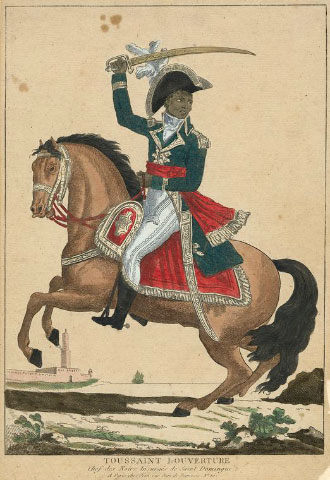Toussaint Louverture 1743 — 1803

Toussaint Louverture and the Haitian Revolution inspired millions of free and enslaved people of African descent to seek freedom and equality throughout the Atlantic world. Toussaint and other black leaders of Saint-Domingue helped to lead the only Atlantic slave society which successfully defeated its oppressors. The former slaves were able to achieve freedom and equality by political and military force, when they defeated the advances of French, British, and Spanish troops. In 1804, they created the second independent Republic in the western hemisphere. As Toussaint Louverture’s life story helps demonstrate, the Haitian Revolution was a complex series of conflicts and alliances between different classes, populations, and political interests.
Toussaint Louverture’s leadership was formed during his early years. Around 1743, he was born with the name, François Dominique Toussaint. His father was an African prisoner of war who was sold into slavery in Saint-Dominque. Toussaint was the eldest of eight children. As a child, he learned to read and write French and Haitian patois, and enjoyed access to books and schooling. His father taught him the use of traditional medicine. Before becoming a coachman for his master, Toussaint herded livestock. Some accounts described him as physically short, skinny, and unattractive, yet charismatic and intelligent. By his mid-thirties, he was free and working toward becoming a property owner.
Saint-Domingue, located in the western region of the island of Hispaniola, was a prized possession of France, due to the wealth derived from the labor of a half-million enslaved people, working primarily in sugarcane and coffee cultivation. In 1791, after the French Revolution, the enslaved people of Saint-Domingue and their allies began a revolution that would last twelve years.
Enslaved Africans in Saint-Domingue faced a harsh and brutal plantation regime. Some Africans escaped the plantations and formed maroon communities, where leaders such as Mackandal, organized resistance. At its immediate outset in 1791, Toussaint was reluctant to join the revolt in the northern province. Despite being free himself, Toussaint saw opportunity in the slave rebellion and joined the fight for liberation. His determination and leadership earned him a promotion to general. By 1793, he had added “Louverture” (French for “opening”) to his name, presumably for his skill in finding or creating openings in enemy lines.
In 1793, warfare between France and Spain provided an opportunity for Louverture to form an alliance with the Spanish, who controlled the eastern side of the island of Hispaniola. The following year, France abolished slavery in the empire. Louverture then joined the French military and helped to repel British and Spanish attempts to take the island. Through a series of political maneuvers and power grabs, Louverture gained control of the whole island and sought to gain French support for his authority. In an 1801 constitution, he named himself as leader for life of a free, autonomous, multiracial Saint-Domingue.
France, now under Napoleon Bonaparte, sent a large force to apprehend Toussaint and restore plantation slavery. After many weeks of fighting, General Charles Leclerc captured Louverture and deported him to the French Alps. With Toussaint Louverture removed from power, Napoleon Bonaparte decreed that slavery be reinstated in all the French colonies in the Americas in 1802. Although Louverture’s arrest began a period of French control on the island, the French victory was short-lived. By 1803 rebel forces were victorious and in 1804 the new and independent Republic of Haiti emerged.







